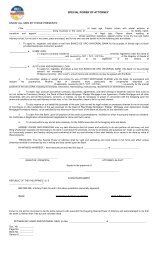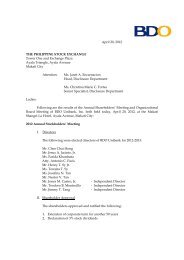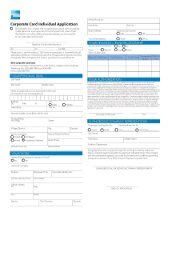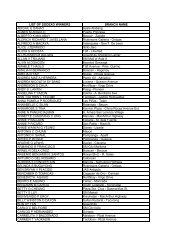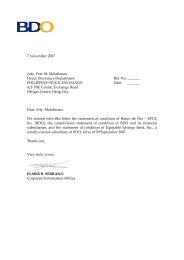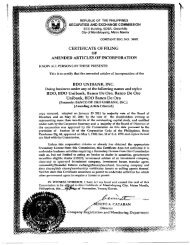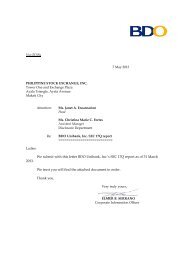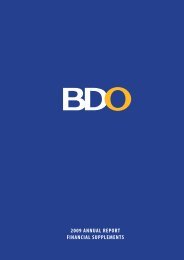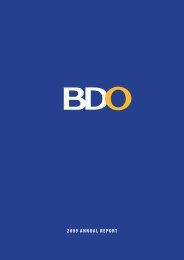Notes to Financial Statements - BDO
Notes to Financial Statements - BDO
Notes to Financial Statements - BDO
Create successful ePaper yourself
Turn your PDF publications into a flip-book with our unique Google optimized e-Paper software.
<strong>Notes</strong> <strong>to</strong> <strong>Financial</strong> <strong>Statements</strong>DECEMBER 31, 2008, 2007 AND 2006(Amounts in Millions Except Per Share Data)When a loan is uncollectible, it is written off, subject <strong>to</strong> BSP guidelines, against the related allowance for loan impairment. Such loans arewritten off after all the necessary procedures, including approval from the management and the Board of Direc<strong>to</strong>rs, have been completedand the amount of the loss has been determined. Subsequent recoveries of amounts previously written off decrease the amount of theimpairment loss in the income statement.If in a subsequent period the amount of the impairment loss decreases and the decrease can be related objectively <strong>to</strong> an event occurringafter the impairment was recognized (such as an improvement in the deb<strong>to</strong>r’s credit rating), the previously recognized impairment loss isreversed by adjusting the allowance account. The amount of the reversal is recognized in the income statement.(b) Assets carried at fair value with changes recognized in equity. In the case of investments classified as AFS financial assets, a significant orprolonged decline in the fair value of the security below its cost is considered in determining whether the assets are impaired. If any suchevidence exists for AFS financial assets, the cumulative loss – measured as the difference between the acquisition cost and the current fairvalue, less any impairment loss on that financial asset previously recognized in profit or loss – is removed from equity and recognized inthe income statement. Impairment losses recognized in the income statement on equity instruments are not reversed through the incomestatement. If, in a subsequent period, the fair value of a debt instrument classified as AFS increases and the increase can be objectivelyrelated <strong>to</strong> an event occurring after the impairment loss was recognized in profit or loss, the impairment loss is reversed through the incomestatement.(c) Assets carried at cost. The Group assesses at each statement of condition date whether there is objective evidence that any of the unquotedequity securities and derivative assets linked <strong>to</strong> and required <strong>to</strong> be settled in such unquoted equity instruments, which are carried at cost,may be impaired. The amount of impairment loss is the difference between the carrying amount of the equity security and the presentvalue of the estimated future cash flows discounted at the current market rate of return of a similar asset. Impairment losses on assetscarried at cost cannot be reversed.Where possible, the Group seeks <strong>to</strong> restructure loans rather than <strong>to</strong> take possession of collateral. This may involve extending the paymentarrangements and the agreement of new loan conditions. Once the terms have been renegotiated, the loan is no longer considered pastdue. Management continuously reviews restructured loans <strong>to</strong> ensure that all criteria are met and that future payments are likely <strong>to</strong> occur.The loans continue <strong>to</strong> be subject <strong>to</strong> an individual or collective impairment assessment, calculated using the loans original effective interestrate. The difference between the recorded sale of the original loan and the present value of the restructured cash flows, discounted at theoriginal effective interest rate, is recognized as part of Impairment Losses account in the income statement.2.21 Impairment of Non-financial AssetsThe Group’s equity investments, intangible assets (recorded as part of Other Resources), premises, furniture, fixtures and equipment andinvestment properties are subject <strong>to</strong> impairment testing. Intangible assets with an indefinite useful life, such as goodwill are tested forimpairment at least annually. All other individual assets or cash-generating units are tested for impairment whenever events or changes incircumstances indicate that the carrying amount may not be recoverable.For purposes of assessing impairment, assets are grouped at the lowest levels for which there are separately identifiable cash flows (cashgeneratingunits).An impairment loss is recognized for the amount by which the asset or cash-generating unit’s carrying amount exceeds its recoverableamount. The recoverable amount is the higher of fair value, reflecting market conditions less costs <strong>to</strong> sell and value in use, based on an internaldiscounted cash flow evaluation. Impairment loss is charged pro-rata <strong>to</strong> the other assets in the cash generating unit.All assets are subsequently reassessed for indications that an impairment loss previously recognized may no longer exist and the carryingamount of the asset is adjusted <strong>to</strong> the recoverable amount resulting in the reversal of the impairment loss.2.22 Functional Currency and Foreign Currency Transactions(a)Functional and Presentation CurrencyItems included in the financial statements of the Group are measured using the currency of the primary economic environment inwhich the entity operates (the functional currency). The financial statements are presented in Philippine peso, which is also the Group’sfunctional and presentation currency. The financial statements of the foreign currency deposit units (FCDUs) of the Group and foreignsubsidiaries are translated at the prevailing current exchange rates (for statement of condition accounts) and average exchange rateduring the period (for income statement accounts) for consolidation purposes.(b)Transactions and BalancesThe accounting records of the Group are maintained in Philippine pesos except for the FCDUs and foreign subsidiaries which aremaintained in US dollars or Euro. <strong>BDO</strong> Remittance, an overseas branch, and Express Padala HK are maintained in Hong Kong dollars.Foreign currency transactions during the period are translated in<strong>to</strong> the functional currency at exchange rates which approximate thoseprevailing on transaction dates.Foreign exchange gains and losses resulting from the settlement of such transactions and from the translation at period-end exchangerates of monetary assets and liabilities denominated in foreign currencies are recognized in the income statement.(c)Translation of <strong>Financial</strong> <strong>Statements</strong> of Foreign Subsidiaries and an Overseas BranchThe operating results and financial position of foreign subsidiaries and an overseas branch, which are measured using the US dollar orEuro and Hong Kong dollars, respectively, their foreign currency, are translated <strong>to</strong> Philippine pesos, the Group’s functional currency asfollows:20Thinking Ahead To Get You Ahead • Annual Report 2008



